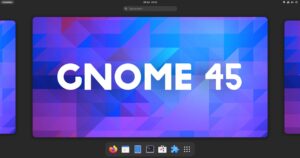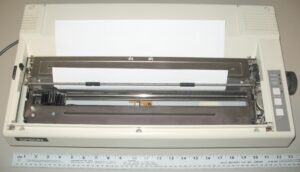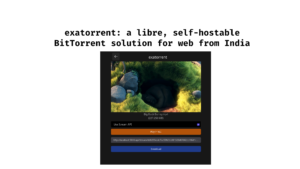Old hardware is not useless, obsolescence is always present in the business, so companies make them useless because if they don’t trash old things, no one will buy new ones. It gets harder for me to understand why people buy newer PCs with latest generation of processors for doing basic things like using Word processing or regular web surfing. Even a few decades old laptop running GNU/Linux is good enough to do these basic tasks, you don’t need an ultra powerful multi-threaded AMD Ryzen processor just for Word processor, web surfing or chatting with friends on your Twitter, it is utter waste of resources. Sometimes, it is notorious tech giants who design their software products such that they mandate new machines for basic things like Email or webmail. But with GNU/Linux and the software freedom it bestows upon us, we can somehow make things viable and transparent even with an old machine for consumers.
There is always a GNU/Linux distribution capable of rejuvenating an old PC!
You can easily find a couple of businesses today selling old Lenovo ThinkPad laptops with GNU/Linux-libre pre-installed with decent specs to sail your boat. Owing to better boot technology or firmware known as Coreboot or Libreboot clubbed with SATA SSDs, these decade old laptops now boot faster than a few budget latest generation laptops, also load your favorite Apps a lot faster than before.
Save our Mother Nature
If we recycle old hardware we are giving it back and being friendly to our mother nature. By not considering our old systems as useful and failing to utilize their true potential and value, we are encouraging OEMs to lure us into buying new things for their billions of dollars of profits. We need to understand and educate people about our planet, the only one we have and if we destroy it we have no home to claim. It is good that some of the new regulations and laws are in place to introduce recyclable material in the process but it is always best to recycle old machines that can still do the job for a couple more years owing to robust build quality back in the days.

Now, you have an old PC or laptop laying around, how do you start? Most people will install it with Windows 7 (which is already outdated and not recommended as per Microsoft) and try using optimization programs to make it usable for a couple of days. You cannot change the core Desktop Encryption owing to the nature of code with Windows, while in GNU/Linux things are different, it is all about choices offered to its users. You can pick a distribution with basic yet usable Desktop environment like LXDE. It is easy on resources but does the job. That being said, a minimum desktop environment called as Window Manager is enough, like Openbox or JWM, obviously with X.org installed. Some experienced users do not use desktop environments or even Window Managers at all, just start an X session and all the session is resource focused for the only programs to run for example MineCraft. For a layman what it means is you do not have ‘Alt+Tab’ neither a menu or desktop with a fancy background.

In a lot of stores the POS or Point of Sell systems runs on dated Windows XP because buying new licenses along slowing down computer performance for a basic thing is a waste of resources and money, so they keep working regardless of the security threat it is to consumer and business data. It is always best to pick a GNU/Linux distribution to replace nasty closed-source software like Windows OS because you get the latest Linux kernel changes and security updates or patches as long as the machine boots or starts.
A full Desktop Environment (a.k.a. DE) is a waste of resources because a layman only use 50% of it, the X.org is focused to use graphical applications not a full DE, full DE is only for very new PCs that have hundreds of programs running in back-end or for people who really need it, like workstations or big rack servers.
We did some real life tests to compare efficiency of a Window Manager only setup and full DE system, also a full DE setup with a vanilla X.org system, the results were interesting.


Openbox and JWM



I use OpenBox mainly because it is minimal, fast and completely configurable. JWM is an alternate to Openbox that I can recommend. Vanilla OpenBox window design is identical to previous versions of Windows OS with support for multiple desktops, configuration options including custom background image with built-in fbpanel which is very low and resources and highly configurable. Vanilla JWM on the other hand is more darker (like modern Night-Mode or Dark-mode skins or themes). It is less adaptive but faster, has an integrated Menu and you do not need to run ´fbpanel´ or such, Alt+Tab is different Openbox show window titles, JWM directly changes through windows, both are customizable with additional packages.

Here is how Minecraft runs on both the WMs:


Truly Interesting, is not it? But what if there is no WM, it is absolutely more faster but hard to control for beginners because the keyboard is taken by the first executed program and you do not have a skin minimize the same. Although everything can be eventually done the command line way too but it can get cumbersome for a lot of consumers.

Vanilla X.org is not visually beautiful as it is all blank screen with no windows to move, minimize or maximize, keyboard is system-default. From command line you can configure various aspects about video (color depth, screen offset, gamma etc) and other system settings. Once you execute to run a program, you won’t find any difference in the visual appearance of the program itself as it would be same as Full Desktop Environment.
Actually, no one runs graphical applications without a basic WM as computers since last few decades are powerful enough to run various Desktop Environment or Windows Managers without causing any major lag to the actual performance of the system.
Unless your job requires modern CPU or GPU intensive raw processing power, kindly consider using your old system with a distribution of GNU/Linux based on OpenBox or JWM or similar Window Manager. It is truly usable and do not require much efforts from you. You can seamlessly browse most of the web, edit your documents, email your friends and even play a lot of 2D/3D games just fine. It would not be a sluggish experience you had with Windows OS. Give GNU/Linux a try and you would not regard it!









